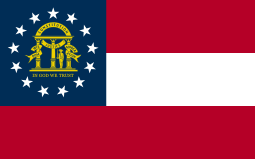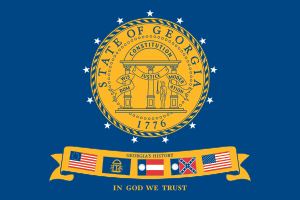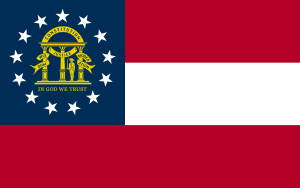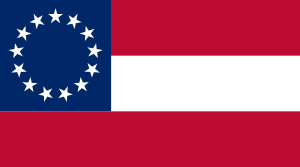Flag of Georgia (U.S. state) facts for kids
The current flag of Georgia was chosen on May 8, 2003. This flag has three stripes: red, white, and red. In the top left corner, called the canton, there is a blue square. Inside this blue square, you'll see a circle of 13 white stars. These stars surround Georgia's coat of arms, which is in gold.
The coat of arms has an arch that stands for the state's constitution. The three pillars represent the three main parts of government: the legislative, executive, and judicial branches. The state motto, "Wisdom, Justice, and Moderation," is wrapped around these pillars. A man dressed in old colonial clothes guards them. Inside the coat of arms, a sword shows that the state will defend its constitution. Below these symbols, you'll find the words "In God We Trust". The 13 stars around the coat of arms remind us that Georgia was one of the original Thirteen Colonies of the United States.
The flag's design is similar to the First National Flag of the Confederacy, also known as the Stars and Bars. After Mississippi changed its flag in 2020, Georgia's flag is one of the few state flags that still refers to the Confederacy. It is also one of only three U.S. state flags that include the words "In God We Trust." The other two are the flags of Florida and Mississippi.
Contents
Early Flags of Georgia
In 1861, Georgia law said that military groups leaving the state should have flags with the state's coat of arms. The law didn't say what color the flag should be. However, one old state flag from that time, kept in a museum, shows the coat of arms on a red background.
Georgia's Flag History
Georgia has changed its state flag several times. Each change tells a part of the state's history.
First Flag (1879–1956)
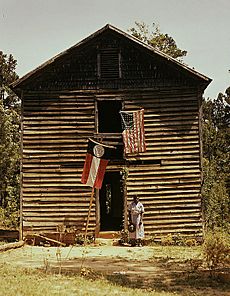
The first official state flag was introduced in 1879 by Herman H. Perry, a state senator. He wanted to honor Confederate soldiers. Perry had been a colonel in the Confederate army. He likely based the flag's design on the First National Flag of the Confederacy, known as the Stars and Bars. This flag had a blue stripe on the left side and red and white stripes.
Over the years, small changes were made to the blue stripe. The original 1879 flag had a plain blue stripe. Later, the state's coat of arms was added to this blue stripe. At first, it was thought that no flags with the coat of arms directly on the blue stripe were made. But by 1904, the coat of arms started appearing on a white shield, sometimes with a gold outline. A red ribbon with the word "GEORGIA" was also added below the shield.
The year on the coat of arms was first 1799, which was when the state seal was adopted. In 1914, the state changed this year to 1776. This was the year the United States Declaration of Independence was signed. Later, the state seal itself began to be used on the flag instead of just the coat of arms. This happened around the 1910s or 1920s.
Second Flag (1956–2001)
In 1955, John Sammons Bell suggested a new state flag. He wanted it to include the Confederate Battle Flag. This new flag was approved and became law on February 13, 1956. It started being used on July 1, 1956.
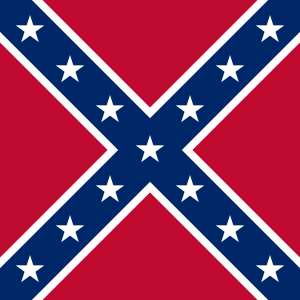
The 1956 flag was adopted during a time when Georgia's government was working to keep racial segregation in place. Segregation was a system that separated people based on race. Many people saw the new flag as a way to show disagreement with the U.S. government's decision to end segregation in schools, known as Brown v. Board of Education (1954).
Some people who supported the flag change later said it was to honor Confederate soldiers. However, a report from 2000 suggested that this reason was given much later. At the time, many people, including some Confederate historical groups, were against changing the flag. They felt it would be too divisive and that people should focus on loyalty to the United States.
Pressure to change the flag grew in the 1990s, especially before the 1996 Summer Olympics in Atlanta. Groups like the National Association for the Advancement of Colored People (NAACP) strongly opposed the flag. Some business leaders worried the flag was hurting Georgia's economy. In 1992, Governor Zell Miller tried to remove the Confederate symbol, but the state legislature did not agree.
Third Flag (2001–2003)
Governor Roy Barnes responded to the calls for a new flag in 2001. He quickly passed a new design through the Georgia General Assembly. This flag, designed by Cecil Alexander, tried to include parts of Georgia's past flags. It featured small images of several old Georgia flags, including the controversial 1956 flag, under the words "Georgia's History." It also showed a 13-star U.S. flag and the current 50-star U.S. flag.
However, this new flag was not popular. A survey in 2001 ranked it as the worst state flag in North America. Many people called it the "Barnes rag." Governor Barnes himself said that the flag was a main reason he lost his re-election two years later.
Fourth Flag (2003–Present)
In 2002, Sonny Perdue became Governor of Georgia. He had promised to let Georgians choose their own flag. In 2003, he allowed the Georgia legislature to create a new flag.
The new flag combined parts of Georgia's earlier flags. Its design was inspired by the First National Flag of the Confederacy, the Stars and Bars. Governor Perdue signed this new flag into law on May 8, 2003.
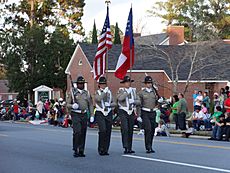
The law also said there would be a vote, called a referendum, to choose between the 2001 flag and the new 2003 flag. The 1956 flag was not an option. This vote happened on March 2, 2004. The 2003 design won with 73.1% of the votes. This is the flag Georgia uses today.
Pledge of Allegiance
Georgians have a special pledge to their state flag:
I pledge allegiance to the Georgia Flag and to the principles for which it stands: Wisdom, Justice, and Moderation.
—Pledge of allegiance to the Georgia state flag
See also
 In Spanish: Bandera de Georgia (Estados Unidos) para niños
In Spanish: Bandera de Georgia (Estados Unidos) para niños
- List of Georgia state symbols
- List of flags by design
- List of U.S. state, district, and territorial insignia


